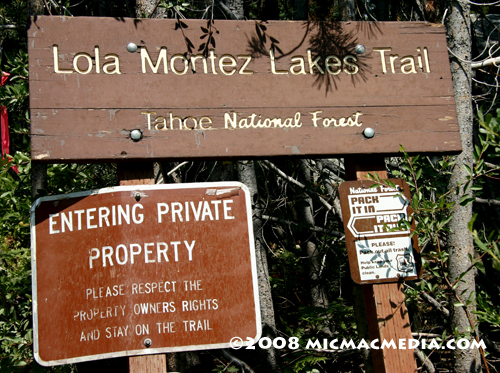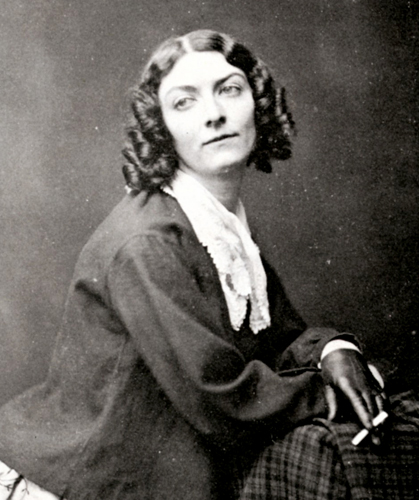 |
|
|
Follow Mark on Facebook for more stories |
||
 |
|||||
|
Tahoe Nugget #143 Lola Montez: The Spider Dancer Yesterday I hiked to Lower Lola Montez Lake, a small, but picturesque spot above Donner Pass. The trailhead is located just north of Interstate 80 and the walk is a relatively easy 7-mile roundtrip starting at 6,640 feet elevation with the lake itself nestled in at 7,200. Much of the trail is on private property so a good portion of the hike is on a gravel road, which makes the route popular with mountain bikers. The trail climbs the south side of the mountain so during July and August it's probably best to hit it early in the day to avoid hiking under a blazing sun, like I did. The lake is named for Lola Montez, a controversial stage actress who entertained thousands during the California gold rush. In July 1854, Montez joined several friends for an extended horse-packing trip into the Sierra and several topographical features were named for her, including 9,148-foot high Mount Lola, and of Upper and Lower Lola Montez lakes. I recently ran a two-part story about Lola Montez in one of my magazine columns. I've edited it for brevity and included it here. The most famous woman to try her luck in California during the gold rush era was Lola Montez, an internationally known, Irish-born dancer and stage actress who had previously shocked critics and audiences in Europe with her risqué personal behavior and seductive stage performances. She was beautiful, sexy and liberated, and therefore controversial amid the highly conservative social mores of the Victorian Age. One admiring French critic wrote, "The dance of Lola Montez is poetry in motion, sometimes fantastic, often lascivious, always attractive." After Lola Montez conquered the European stage and concert halls, she was ready to take on the United States. Her manager worried if the more conservative American audiences would be receptive to her extraverted on-stage sexuality, but there was little to be concerned about. Theater-goers in the big cities along the Atlantic Coast generally reactively favorably to Lola's acting ability, as well as to her exotic, self-created "Spider Dance" performances. During her Spider Dance, Lola frequently lifted up the folds of her skirt as if she had just discovered imaginary spiders in her dress. Under her multi-colored petticoats were flesh-colored tights. It was a daring move that could just as likely draw cheers of excitement or jeers of scorn depending on the crowd. Indicative of the morally conflicted emotions that Lola Montez's daring reputation on stage and in real-life often generated, Mary Jane Megquier, wife of a physician and the proprietress of a San Francisco boardinghouse who spent her days cooking and cleaning, wrote "Lola Montez is making quite a stir here now but many say that her playing is of a character that is not proper for respectable ladies to attend, but I do want to see her very much." Lola Montez had always blazed her own path, no matter how controversial. Historian Bruce Seymour wrote, "Her will was as great as her charm and her ego was as impressive as her beauty." In her 20-year, self-made career, she became the most talked about woman of her time and is the inspiration for the timeless expression "Whatever Lola wants, Lola gets." Lola was born Elizabeth Rosanna Gilbert in Ireland, on February 17, 1821. Her father, Edward Gilbert, was an officer in the British army and her mother was the illegitimate daughter of a wealthy and powerful Irish politician. When "Eliza" turned three years old, the family moved to India where her father died of cholera just a few months after their arrival. Within a year her mother remarried and Eliza was sent to live with relatives in Scotland. When she reached the age of 11 she was enrolled in an English boarding school where she received an education in the liberal arts. When Eliza turned 16, her mother proposed that it was time for marriage. Her mother's matrimonial plans left Eliza cold so she rebelled and eloped with a handsome, 30-year old army lieutenant named Thomas James, who just happened to be an "admirer" of Mrs. Gilbert and who had traveled from India with her. But after a few years Eliza grew unhappy with her marriage and returned to Scotland alone. Mrs. Eliza James was now only 19 years old, but her reputation was already soiled by her elopement with an older man and she had no chance at an honest relationship as long as she was still married to Lt. James. These became minor details to the young and spirited Eliza and within ten days of boarding the London-bound ship she started an affair with another military officer. When news of the scandalous activity reached Lt. James, he charged Eliza with adultery and sued for divorce. Eliza escaped the shame of appearing in an English divorce court by traveling to Spain to create a new persona for herself. She took acting classes, learned traditional Spanish dances and began smoking cigarettes and cigars. Upon her return to England in 1842, she hit the stage as "Lola Montez, the Spanish Dancer." Over the next two decades, she would become the most notorious of 19th-century courtesans and her adventures and affairs became the fodder for worldwide gossip and countless newspaper articles. Wherever Lola Montez went, heads turned and tales of scandal flourished. Her striking beauty garnered immediate attention from everyone she met, with her fair skin, jet-black hair and large, deep-blue eyes. Everyone knew that she had captivated the hearts and minds of famous and powerful men as she danced seductively on stages throughout Europe. Among her notable lovers were the Hungarian composer and piano virtuoso Franz Liszt, as well as King Ludwig I of Bavaria. During Lola's sensational performance tour of Germany, the aging King Ludwig was so enamored that he showered her with gifts and jewels. But the real trouble started when he awarded Lola the title of Countess of Landsfeld and asked her to help him rule the country. When the people of Bavaria discovered the royal privileges given their king's new mistress, they revolted and rioted in the streets, chanting slogans condemning Countess Montez. The angry crowds forced Ms. Montez to flee while the disgraced king abdicated his throne. Lola Montez traveled to San Francisco in May 1853. At the age of 30, Lola had already been married three times and had had numerous high profile sexual affairs. In keeping with her spontaneous nature, two months after Lola arrived in California she married Patrick Hull, a 32-year-old San Francisco journalist whom she had just met in Panama while making the final leg of the journey from New Orleans to San Francisco. She married Hull in a Catholic ceremony at a local church, despite the fact that she had not yet divorced her two previous husbands. That afternoon the newlyweds sailed for Sacramento to begin Lola's tour of the California mining camps in the Sierra foothills. The couple had seemed happy in San Francisco, but shortly after Lola began her show tour their marriage fell apart and Montez initiated divorce proceedings against Hull claiming incompatibility. A few months later Lola Montez suddenly decided to quit the stage and she moved to the foothill town of Grass Valley where she purchased a small cottage. The actress spent the next two years in Grass Valley hunting, exploring the mines and entertaining her many visitors. Lola Montez had stormed into the Golden State and then quickly "retired" in the Sierra foothills, but by 1855 she had either renewed her love for performance or was running out of money. Gold had been recently discovered in Australia and Lola decided that a tour "down under" would refill her coffers. Once in Australia, however, Lola's temper tantrums and dysfunctional love affairs broke up her troupe. While returning to California, her agent and current lover Noel Follin, angry with Lola for cheating on him, committed suicide at sea. Depressed and suicidal herself, Montez performed a few more times in San Francisco and Sacramento before selling her properties and jewelry collection and moving to New York City. In New York, Lola became repentant and an avid fan of Spiritualism, whose followers held séances to converse with the dead. In June 1860 she suffered a major stroke and was partially paralyzed for some time. In mid-December she had recovered enough strength to begin walking again, but that winter she contracted pneumonia and died on January 17, 1861, at the age of 42. She died using the family name of Eliza Gilbert and, unknown to the world, was buried at Greenwood Cemetery in Brooklyn, N.Y. Lola Montez was a troubled woman who lived a wild life, but along the way she helped many others who were less fortunate than her. During her stay in Grass Valley, she taught performance art to Lotta Crabtree, a talented eight-year-old who became the "Shirley Temple" of her day. Lotta later became one of the first American comediennes and the highest paid actress in the United States. But that's a Nugget for another day. Photo #1: Trailhead just off westbound Interstate 80 at Soda Springs exit.
|
|||||
|








